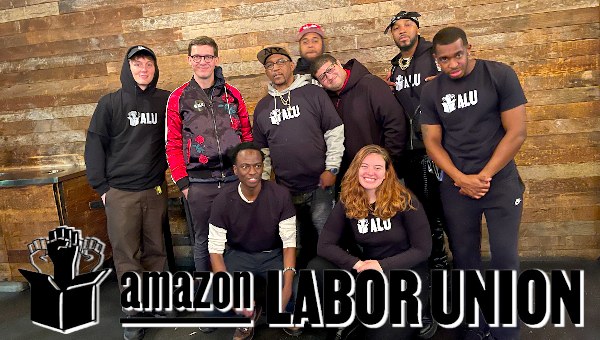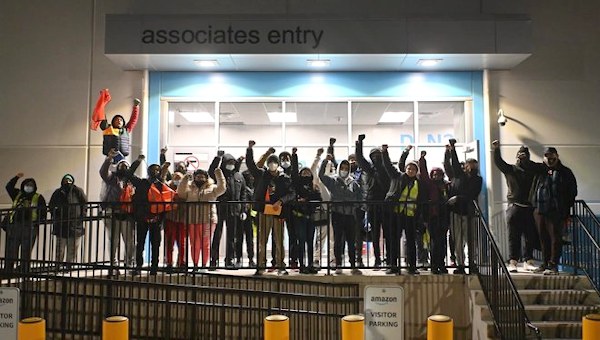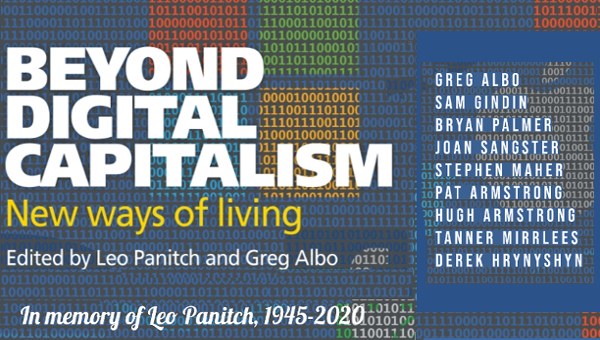The fight against the sharing economy, and Uber in particular, can be disorienting. Opposition is often painted as techno-phobia. The good guys in this story are Uber and progress; on the other side are opponents afraid of flexibility and smartphones, kicking and screaming against a future already here. In many ways, this is like the fight of the Luddites (machine smashers) 200 years ago at the dawn of the Industrial Revolution. While the Luddites were fighting the way technology was used to further exploit rather than liberate workers, they were and are misrepresented as simply being afraid of and opposing technology.

Just as power looms and other machines inaugurated a technological revolution that ultimately produced more work for the many and greater wealth for the few, so too are modern technologies enriching Silicon Valley’s billionaires at the expense of drivers, delivery folk and all manner of service workers. The sharing economy that consumers experience as a friendly convenience is, for workers, a low-wage, precarious trap. It would sound all too familiar for the skilled cloth-makers who wanted machines to give them more leisure and continued control over their work, but instead found themselves subsidizing the profits of the machine owners in England’s “satanic mills.”
Today, few technologies have as much potential for easy cooperative management as those of the currenly mislabelled sharing economy. These tools are not to blame. In fact, internet-based technologies are an opportunity for worker management. As Mike Konczal wrote in The Nation a year ago:
“Given that the workers already own all the capital in the form of their cars, why aren’t they collecting all the profits? Worker cooperatives are difficult to start when there’s massive capital needed up front, or when it’s necessary to coordinate a lot of different types of workers… If any set of companies deserves to have its rentiers euthanized, it’s those of the ‘sharing economy’, in which management relies heavily on the individual ownership of capital, providing only coordination and branding.”
Silicon Valley’s version of sharing means that while we carry the risks of illness, breakdown and everything else that comes with owning our tools – the cars that we drive for Uber or the computers we use for online Taskrabbit chores – they get to say how the gains from our services are distributed. The Luddites surely would be impressed that technology owners can now get rich simply by connecting people with each other. If looms and frames were the symbol for Luddites of their degradation, today’s drivers, couriers and taskrabbits can only point to ephemeral platforms and apps. While the Luddites attacked their bosses by destroying their looms and faced violent reprisals sanctioned by law, the privately-run digital networks of today are virtually impossible to physically disrupt while having the full force of the law behind them.
Instead of producing greater socialization that spreads wealth and decision-making, the sharing economy funnels money and control toward the top. Yet today’s world still has space for some pretty old-school demands the Luddites would recognize. They wanted to work less and have a say over how they worked (with technology!). We too could be using the fruits of technology to get ever-shorter workweeks, cooperate more and manage aspects of the economy together.
Faced wth the charge of techno-phobia, we must remember that the fight against Uber is a fight for a technology that could be used to distribute work more equally and foster genuine cooperation. That fight, I hope, won’t be misremembered in some dystopian twenty-third century capitalism. Though I’m sure the Luddites would have had the same hopes of us. •
UberXploited: Behind the Toronto Taxi Wars
David Bush
On Wednesday December 9, taxi drivers in Toronto took their battle against Uber to the streets. The protest was just the latest salvo in an increasingly bitter and seemingly complex war over the future of the city’s taxi industry. Since Uber rolled into Toronto in 2012 it has dramatically shaken up the city’s taxi industry and taxi drivers have been paying the price. Much of the mainstream press has covered this story as a battle between taxi license holders and Uber; a fight between an old corrupt system and a modern technological innovation. This tale of selfish cabbies versus the future was on full display after the protest as the press denounced protesting taxi drivers as “living in an illusion” and displaying “outrageous behaviour.” To understand why Toronto taxi drivers have been taking to the streets, lobbying city hall, and even going on hunger strike, we need to understand the industry.
Toronto’s Taxis
Taxis are a regulated and licensed industry in Toronto with about 4,800 licenses being issued. 3,451 are standard licenses that do not require the owner to be operator. Before 1998, the last time the taxi industry was reformed, this was the only type of license. The 1998 reform to the taxi industry brought in the ambassador license. This was a compromise, not a true overhaul and reform of the system. Ambassador licences are owner-operator licenses and there are currently 1,313 issued in the city. There are also 85 accessible licenses for taxis that can serve people with disabilities. Since Uber has entered the Toronto taxi market, the value of the standard plate licenses have plummeted from highs of over $300,000 in 2012 to around a third of that.
Taxi operations, their fares, car standards, refusal of rides, luggage, passenger numbers, are set by the city. Taxis are also subjected to inspections twice a year. And most importantly taxis are required to have $2-million in comprehensive commercial insurance.
The other side of the standard plate system are the drivers. There are roughly 10,000 taxi drivers in the city. Each taxi driver is registered with the city, and has to pay fees, and meet standards such as up-to-date licenses and criminal record checks. These expenses come out of pocket. Drivers for the most part break into the industry in shift work, where they rent out vehicles with plates. The average full-time shift worker makes roughly $31,000 a year. That is calculated working 12 hour shifts, six days a week and it works out to $8.60/hr, well below the minimum wage of $11.25/hr. Taxi drivers, whether they own a plate or not, are classified as independent contractors and thus can’t form a legally recognized union. Taxi drivers in Toronto are highly racialized. Over 80 per cent of taxi drivers in the city are immigrants, nearly half of the immigrant cab drivers come from either Pakistan or India.
Uber
Uber, is a $40-billion global corporation, which offers a variety of ridesharing services. While Uber came to Toronto in 2012, its UberX taxi operations didn’t start until 2014. They have roughly 16,000 drivers and nearly 85 per cent of their business is through UberX.
The company claims to be simply connecting riders and drivers via an app and then taking a fee. But they also offer a rating service and have their own internal standards for both riders and drivers. They operate based on a fluid pricing system. While their base fare price is lower than licensed taxis by about 30 per cent, they also use “surge pricing” which can dramatically raise prices if demand is high. Uber is clearly aiming to undercut its more regulated counterparts and put them out of business. Pay at Uber is low. They pay less per kilometre than taxis.
Uber also sets its own standards, which are unsurprisingly lower than the city’s in every respect. UberX cars aren’t subjected to inspection and they can be up to ten years old. And most significantly, they do not carry proper commercial insurance. Uber demands its drivers have up-to-date private insurance for their car, but this is private insurance. Both the Financial Services Commission of Ontario and the Insurance Board of Canada have warned about the inadequacy and risk of personal auto insurance in terms of proper coverage when using a personal vehicle as a taxi.
Uber denies it is an employer of taxi drivers, despite losing a significant California court case this fall claiming otherwise. Uber maintains it is simply a web-based communications company connecting riders and drivers. However, through their internal rating system they control who works and who doesn’t, and the rate of pay. Most UberX drivers are part-time and the fact that they must own their vehicle and are publicly rated (all drivers must maintain a 4.6 out of 5 rating to keep getting rides) means the demographic make-up of Uber drivers is quite likely very different than taxi drivers. There is no hard data available yet for Toronto, but surveys in the U.S. show that Uber drivers are younger and whiter than their taxi driver counterparts.
Whose Reform?
In early 2014, after four years of lobbying and public pressure by iTaxiworkers association, the taxi driver association in the GTA, taxi drivers won a 10-year phase-in to an owner-operator model for all taxi licenses. The proposed new Toronto Taxi Licenses (TTL) would have required license holders to actually drive a set amount of hours (roughly 160 hours per month). This would prevent people from holding multiple licenses, and curb some of the rotten employment standards found in the industry.
After the municipal election in 2014, a new council and a newly-appointed committee that oversaw the taxi industry began to backtrack on the TTL. Holders of the standard taxi license plates lobbied hard for the council to review the reforms. But it wasn’t just the big bad plate holders who were opposed to the TTL. Advocates of the reform also began to question the new taxi regulations in the wake of UberX’s Toronto launch in the fall of 2014. Some understandably wanted new reforms to also include and address the new reality of Uber. Others, with less genuine hearts, saw an opportunity to push through a total revamp of the industry. This includes Mayor John Tory who is a strong advocate of two-tier regulations: one for taxis and one for Uber. He also has close ties with Uber. Two key members of his campaign staff now work for Uber.
After UberX’s launch, the city issued an injunction to stop UberX’s activities in the late fall of 2014. When the council came again to revisit the question of the TTL, Mayor John Tory fought for and won a delay until the the court injunction was resolved. The city lost the injunction in the summer of 2015 and reform came back to the table in the fall. But this time instead of being about moving to an owner-operator model, it was about lowering taxi fares and creating a second track of regulation for Uber, which most certainly will be bad news for taxi drivers. The heavily-divided council has postponed any regulation until a staff report comes out in the spring of 2016. To protest this, hundreds of taxi drivers, organized with iTaxiworkers, showed up at the meeting wearing t-shirts saying “No two-tier system.” In the meantime Uber and its supporters are pushing the idea of two-track regulation, while standard plate holders are seeking to both stamp out Uber and crush the TTL reform. City council also passed a motion asking Uber to cease its operations until regulations are brought in. Uber has refused, saying its responsibilities are with its riders, not the city.
At its core, this story is about some of the most marginalized workers in our city standing up and fighting for justice. The entrenched powers in the taxi industry want to keep the status quo, while taxi drivers have been fighting tooth and nail to improve the conditions and regulations.
To some, the introduction of Uber may seem like a good opportunity to resolve longstanding problems in the industry. But the reality is Uber has derailed real reform efforts and has caused undue suffering for taxi drivers. It has driven down standards, suppressed wages and made real change more difficult. This is why taxi drivers are taking to the streets.
The taxi wars in Toronto isn’t a story about taxis versus Uber. It is a story about workers standing up for their livelihoods and rights against a system, a $40-billion corporation, and a city that doesn’t care about them. •
David Bush is an editor at RankandFile.ca where this article first appeared.





